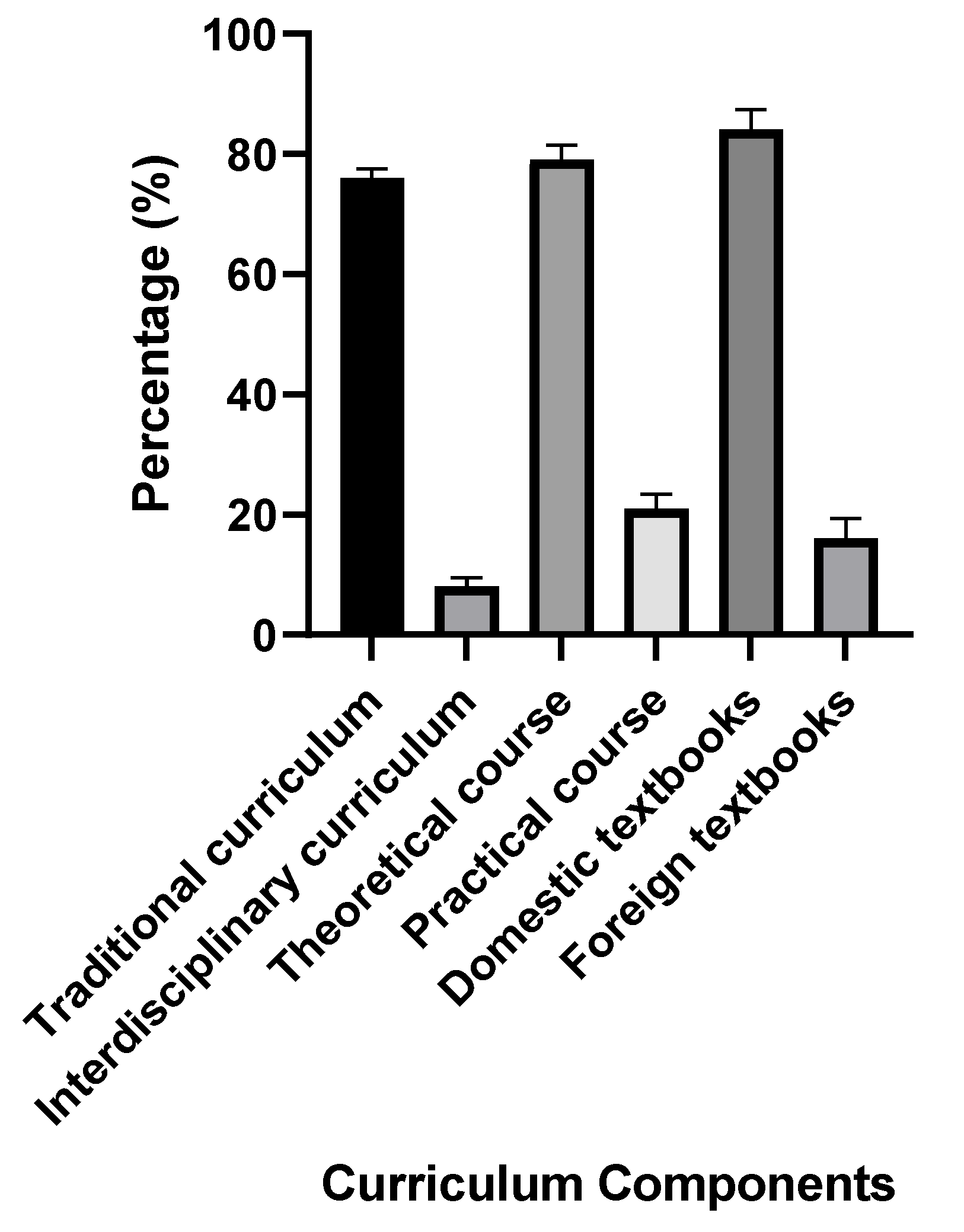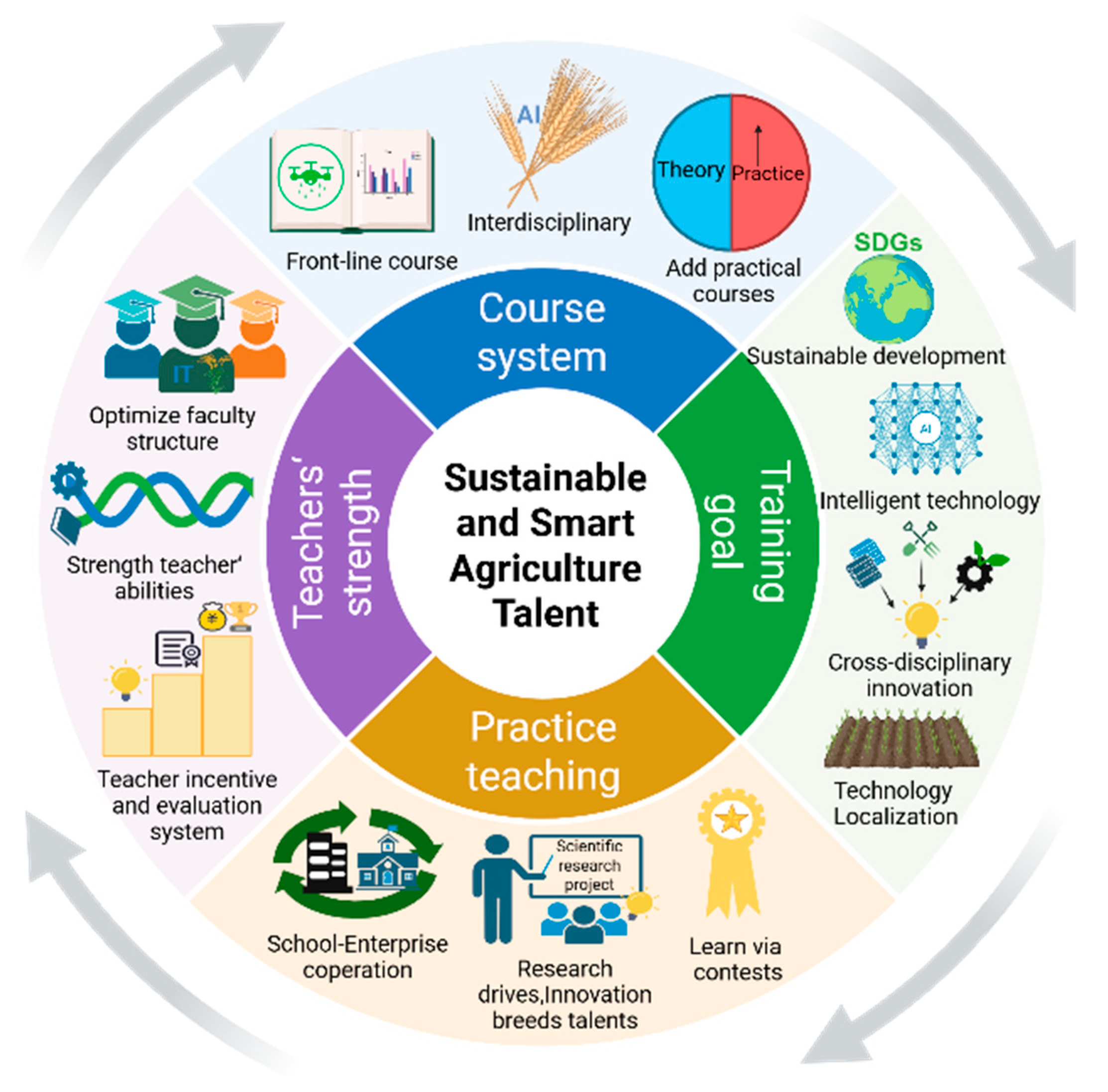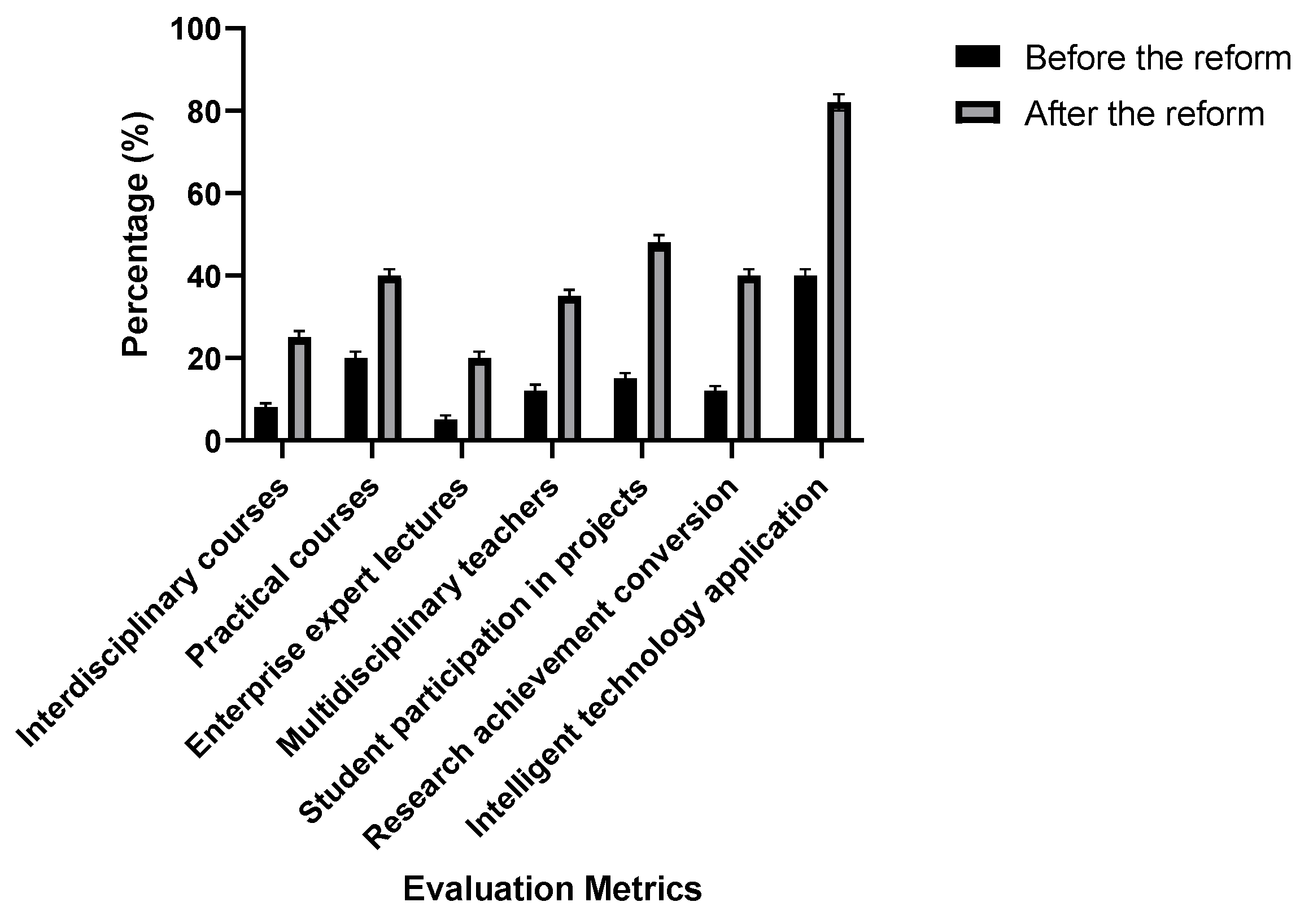Cultivating Talents at Tertiary Agricultural Institutions in China for Sustainable and Intelligent Development
Abstract
1. Introduction
2. Materials and Methods
2.1. Literature Analysis
2.2. Case Analysis
2.3. Questionnaire Survey
2.4. Qualitative Data Collection and Analysis
3. Analysis of Current Talent Cultivation in Tertiary Agricultural Institutions in China
3.1. Overview of Tertiary Agricultural Institutions in China
3.2. Current Status of Agricultural Talent Cultivation Models
3.2.1. Analysis of Current Educational Objectives
3.2.2. Curricula Systems
3.2.3. Analysis of Current Practical Training
3.2.4. Analysis of Current Faculty Structure
3.3. Major Existing Problems
3.3.1. Misalignment Between Educational Objectives and the Demands of Sustainable and Intelligent Agriculture Development
3.3.2. Outdated Curricula Lack Relevance for Emerging Technologies and Interdisciplinary Integration
3.3.3. Deficient Practical Training Constrains the Development of Students’ Innovation Capability
3.3.4. Irrational Faculty Structure with Deficient Interdisciplinary Expertise and Practical Experience
3.4. Synthesis of Key Challenges and Proposed Solutions
4. Construction of a Talent Cultivation Model Oriented to Sustainable and Intelligent Agriculture
4.1. Proposed Educational Objectives for the OCPF Model
- Sustainable Philosophy: Understanding the core principles of agricultural ecosystem balance, resource recycling, and low-carbon production, coupled with the ability to formulate agricultural solutions that align with the UN’s Sustainable Development Goals (SDGs) [23].
- Intelligent Technology Application: Proficiency in applying IoT, big data analytics, artificial intelligence (AI), and blockchain technology in agriculture to optimize the management of whole-chain agricultural production [27].
- Cross-domain Innovation Capability: Competence in integrating multidisciplinary knowledge (e.g., agronomy, information science, and environmental engineering) to effectively address complex agricultural challenges such as climate change and precision resource management.
- Global–Local Integration: The ability to stay abreast of international frontiers in agricultural technology while adapting to the specific context of China, thereby promoting contextualized applications of technologies.
4.2. Proposed Curricular System for the OCPF Model
4.2.1. Introducing Developmental Courses to Strengthen Technology-Driven Learning
4.2.2. Promoting Interdisciplinary Integration and Reconstruction of Knowledge Frameworks
4.2.3. Optimizing Theory–Practice Balance to Enhance Application Capabilities
4.3. Proposed Practical Training in the OCPF Model
4.3.1. Deepening Industry–Academia Integration to Build Integrated Ecosystems
4.3.2. Research Project-Driven Innovation Capability Cultivation
4.3.3. Competition-Enhanced Learning to Stimulate Practical Competence
4.4. Faculty Development
4.4.1. Optimizing Faculty Structure by Introducing Interdisciplinary Talents
4.4.2. Enhancing Faculty Capacity Building to Break Down Knowledge Barriers
4.4.3. Establishing Faculty Incentives and Evaluation Systems
5. Case Analysis: An In-Depth Study of Yangzhou University
5.1. Educational Objectives
- Sustainability Literacy: The university embedded principles of “efficient agricultural resource utilization” and “low-carbon circular agriculture” into professional standards. As such, competency is certified not through written exams but via practical demonstrations of proficiency conducted at the university’s Smart Agriculture Training Base, ensuring that skills are industry-ready.
- Intelligent Technology Application: A “Smart Agriculture” micro-credential program was established, making proficiency in at least two core technologies a mandatory requirement (e.g., agricultural drone operation and remote sensing data analysis). Competency is certified not through written exams but via practical demonstrations conducted at the university’s Smart Agriculture Training Base, ensuring skills are industry-ready.
- Industry Alignment: Co-developed with the Jiangsu Provincial Department of Agriculture and Rural Affairs, students’ attainment of these competencies is evaluated through their performance in authentic, industry-sponsored projects, creating a direct feedback loop between market needs and educational outcomes.
- Innovation–Entrepreneurship Orientation: The university implemented “innovation credits”, allowing participation in competitions or entrepreneurship to substitute traditional course credits. Here, performance in national events like the Smart Agriculture Innovation Contest becomes a direct and high-stakes metric for evaluating innovative capabilities, directly linking extracurricular achievement to academic credit.
- SDGs Integration Plan: The UN’s SDGs are embedded in the practice modules of traditional majors. Courses such as Rice Cultivation and Carbon Neutrality assess students’ knowledge of sustainability by requiring them to design solutions for specific targets—such as modeling a 30% cut in carbon emissions—merging theoretical knowledge with practical results-driven design.
5.2. Curricula
- Innovative Technology Course Clusters: New courses, including Agricultural Big Data Mining, Intelligent Agricultural Machinery Systems Design and Blockchain and Agricultural Product Traceability, comprise 25% of total professional credits. The pioneering course, Agricultural Metaverse and Virtual Farms, employs VR and AR technologies to simulate smart agriculture scenarios.
- Interdisciplinary Course Packages: Cross-disciplinary courses, such as Bioinformatics and AI and Agricultural Economics and Digital Marketing, allow students to earn 30% of their credits from the School of Information Science (e.g., agronomy majors taking Python Applications in Agriculture).
- Dynamic Update Mechanism: A curriculum committee involving industry experts from DJI Agriculture evaluates the technological relevance of 30% of the course content annually. In 2023, Generative AI Tools (e.g., ChatGPT, OpenAI, version as of 2023) in Agricultural Consulting was added as an elective that explicitly addresses technical principles and agricultural applicability.
- According to the 2022 Curriculum Evaluation Report, students’ satisfaction with new smart agriculture courses reached 89%, which is 23% higher than satisfaction rates for traditional courses.
5.3. Practical Training
- Foundational Training Tier: The campus features a 33-acre (200 mu) Smart Agriculture Training Base equipped with unmanned agricultural aircraft, multispectral drones, and intelligent greenhouse systems, with 5000 h of annual equipment operation.
- Industrial Application Tier: Twelve field laboratories co-built with the Jiangsu Agricultural Reclamation Group and Longping High-Tech company have implemented authentic problem-solving projects. In 2022, students majoring in agronomy developed a Digital Rice–Wheat Rotation Management System and deployed it at Yancheng farms, reducing the use of fertilizer by 18%.
- Innovation Tier: The Qinghe Maker Center funded 17 student entrepreneurship projects from 2021 to 2023 with RMB 5 million provided for seed funding, including AI Crab Pond Water Quality Monitoring and Straw-Based Biodegradable Mulch Film; three projects won the national innovation gold awards.
- Dual-Supervision System: Under the dual guidance of enterprise engineers and academic mentors, Ph.D. candidates at the Yangzhou University–Syngenta Joint Lab have developed the “Wheat Fusarium Head Blight Intelligent Early-Warning Model”. This model has been promoted nationwide by the Ministry of Agriculture.
5.4. Faculty Expertise
- High-End Talent Recruitment: Six professors, each possessing over three years of dual expertise in agriculture and information technology, were introduced, including one chief scientist of the national smart agriculture R&D program. In addition, interdisciplinary teams (e.g., from Agricultural AI and Digital Rural Planning) were established.
- Faculty Capacity Development: A Dual-Qualified Teacher Certification Program was implemented, requiring six months of cumulative enterprise practice or technical training every five years. In addition, 15 faculty members were dispatched abroad in 2023 to study vertical farming technologies.
- Industry Expert Engagement: Enterprise specialists, including Digital Agriculture Directors and Agri-Product Supply Chain Experts, were appointed as adjunct professors, teaching courses such as Intelligent Breeding Industrialization and Agri-product E-commerce Practice. The industry-expert instruction rate reached 20%. By 2023, the number of faculty members with interdisciplinary expertise increased from 12% (2018) to 35%, and over RMB 30 million of industry-sponsored research projects on smart agriculture was secured.
5.5. Successful Experiences and Scaling Impact
- Curriculum Enhancement: The proportion of emerging interdisciplinary courses increased from 8% to 25%, while practical courses rose from 20% to 40%. Additionally, satisfaction with new courses reached 89%.
- Stakeholder Synergy: The involvement of industry experts in teaching grew from 5% to 20%, and the percentage of faculty members with interdisciplinary backgrounds saw a substantial increase from 12% to 35%. Furthermore, students’ participation in authentic industry projects surged from 15% to 48%.
- Student Capability Leap: The rates of research commercialization climbed from 12% to 40%, and intelligent technology proficiency increased from 40% to 82%. Notably, the 2022 cohort averaged 1.2 practical achievement certificates per graduate.
6. Discussion
7. Conclusions
Author Contributions
Funding
Institutional Review Board Statement
Informed Consent Statement
Data Availability Statement
Conflicts of Interest
References
- Ma, L.; Long, H.L.; Zhang, Y.N.; Tu, S.S.; Ge, D.Z.; Tu, X.S. Agricultural labor changes and agricultural economic development in China and their implications for rural vitalization. J. Geogr. Sci. 2019, 29, 163–179. [Google Scholar] [CrossRef]
- Zhang, Y.; Diao, X. The changing role of agriculture with economic structural change—The case of China. China Econ. Rev. 2020, 62, 101504. [Google Scholar] [CrossRef]
- Yu, K.X.; Zhao, S.Q.; Sun, B.; Jiang, H.W.; Hu, L.M.; Xu, C.; Yang, M.L.; Han, X.; Chen, Q.S.; Qi, Z.M. Enhancing Food Production Through Modern Agricultural Technology. Plant Cell Environ. 2024; early view. [Google Scholar] [CrossRef]
- Yang, Y.; Tilman, D.; Jin, Z.; Smith, P.; Barrett, C.B.; Zhu, Y.-G.; Burney, J.; D’Odorico, P.; Fantke, P.; Fargione, J.; et al. Climate change exacerbates the environmental impacts of agriculture. Science 2024, 385, eadn3747. [Google Scholar] [CrossRef] [PubMed]
- Ren, X.C.; He, J.; Huang, Z.L. Innovation, natural resources abundance, climate change and green growth in agriculture. Resour. Policy 2023, 85, 103970. [Google Scholar] [CrossRef]
- Prosekov, A.Y.; Ivanova, S.A. Food security: The challenge of the present. Geoforum 2018, 91, 73–77. [Google Scholar] [CrossRef]
- Su, G.; Chen, Z.; Li, W.; Xia, X. Study on the Impact of the Rural Population Aging on Agricultural Total Factor Productivity in China. Agriculture 2024, 14, 2175. [Google Scholar] [CrossRef]
- Meng, X.; Yang, S.; Pan, G. Innovation practices in agricultural transformation in East China: Exploring the impact and implications of the new professional farmer training model. Heliyon 2024, 10, e34671. [Google Scholar] [CrossRef]
- Yang, X.; Shu, L.; Chen, J.; Ferrag, M.A.; Wu, J.; Nurellari, E.; Huang, K. A Survey on Smart Agriculture: Development Modes, Technologies, and Security and Privacy Challenges. IEEE-CAA J. Autom. Sin. 2021, 8, 273–302. [Google Scholar] [CrossRef]
- Wang, Y.; Wang, X.; Liu, Y. Research on the Path of “New Agriscience” Talents Cultivation Under the Background of Rural Revitalization. In Proceedings of the 2021 International Conference on Social Sciences and Big Data Application (ICSSBDA 2021), Xi’an, China, 17–18 October 2021. [Google Scholar]
- Xu, H. Chinese Digital Economy: Current Situations, Problems, and Recommendations. Adv. Econ. Manag. Political Sci. 2024, 98, 198–207. [Google Scholar] [CrossRef]
- Liu, S.Y. Towards a sustainable agriculture: Achievements and challenges of Sustainable Development Goal Indicator 2.4.1. Glob. Food Secur. Agric. Policy Econ. Environ. 2023, 37, 100694. [Google Scholar] [CrossRef]
- Dantsis, T.; Loumou, A.; Giourga, C. Organic Agriculture’s Approach towards Sustainability; Its Relationship with the AgroIndustrial Complex, A Case Study in Central Macedonia, Greece. J. Agric. Environ. Ethics 2009, 22, 197–216. [Google Scholar] [CrossRef]
- Huan, H.F.; Wang, L.; Zhang, Y. Regional differences, convergence characteristics, and carbon peaking prediction of agricultural carbon emissions in China. Environ. Pollut. 2025, 366, 125477. [Google Scholar] [CrossRef]
- Albiero, D.; Paulo, R.; Junior, J.; Santos, J.; Melo, R. Agriculture 4.0: A terminological introduction. Rev. Ciênc. Agron. 2020, 51, e20207737. [Google Scholar] [CrossRef]
- Cariou, C.; Moiroux-Arvis, L.; Pinet, F.; Chanet, J.-P. Internet of Underground Things in Agriculture 4.0: Challenges, Applications and Perspectives. Sensors 2023, 23, 4058. [Google Scholar] [CrossRef] [PubMed]
- Javaid, M.; Haleem, A.; Singh, R.P.; Suman, R. Enhancing smart farming through the applications of Agriculture 4.0 technologies. Int. J. Intell. Netw. 2022, 3, 150–164. [Google Scholar] [CrossRef]
- Das, S.; Kaur, M.; Chhabra, V.; Nandi, T.; Mishra, P.; Ghosh, S. A Systematic Review of Artificial Intelligence: A Future Guide to Sustainable Agriculture. Int. J. Environ. Clim. Change 2024, 14, 562–573. [Google Scholar] [CrossRef]
- Addas, A.; Tahir, M.; Ismat, N. Enhancing Precision of Crop Farming towards Smart Cities: An Application of Artificial Intelligence. Sustainability 2024, 16, 355. [Google Scholar] [CrossRef]
- Li, D.P.; Nanseki, T. Review of the Practice, Promotion, and Perspective of Smart Agriculture in China. J. Fac. Agric. Kyushu Univ. 2022, 67, 227–237. [Google Scholar] [CrossRef]
- Xi, Z. Discussion on New Approach to Employment of Graduates in Agricultural and Forestry Universities in a New Situation. Asian Soc. Sci. 2012, 8, 259. [Google Scholar] [CrossRef]
- Shinwari, S.; Sadat, A.; Mohammadi, Y.; Salihi, M.S. Strategic Analysis of Agriculture Students’ Employability by SWOT Technic. J. Res. Appl. Sci. Biotechnol. 2023, 2, 100–105. [Google Scholar] [CrossRef]
- Atapattu, A.J.; Ranasinghe, C.; Udumann, S.S.; Nuwarapaksha, T.; Dissanayaka, N. Sustainable Agriculture and Sustainable Development Goals (SDGs). In Emerging Technologies and Marketing Strategies for Sustainable Agriculture; IGI Global Scientific Publishing: Hershey, PA, USA, 2024; pp. 1–27. [Google Scholar]
- Soam, S.K.; Subbanna, Y.B.; Rathore, S.; Kumar, V.V.S.; Kumar, S.; Vinayagam, S.S.; Rakesh, S.; Balasani, R.; Raju, D.T.; Kumar, A.; et al. Academia-Industry Linkages for Sustainable Innovation in Agriculture Higher Education in India. Sustainability 2023, 15, 16450. [Google Scholar] [CrossRef]
- Xin, X.; Qin, F. Decomposition of agricultural labor productivity growth and its regional disparity in China. China Agric. Econ. Rev. 2011, 3, 92–100. [Google Scholar] [CrossRef]
- Cui, Y.; Khan, S.U.; Deng, Y.; Zhao, M. Spatiotemporal heterogeneity, convergence and its impact factors: Perspective of carbon emission intensity and carbon emission per capita considering carbon sink effect. Environ. Impact Assess. Rev. 2022, 92, 106699. [Google Scholar] [CrossRef]
- Assimakopoulos, F.; Vassilakis, C.; Margaris, D.; Kotis, K.; Spiliotopoulos, D. The Implementation of “Smart” Technologies in the Agricultural Sector: A Review. Information 2024, 15, 466. [Google Scholar] [CrossRef]
- Valley, W.; Wittman, H.; Jordan, N.; Ahmed, S.; Galt, R. An emerging signature pedagogy for sustainable food systems education. Renew. Agric. Food Syst. 2017, 33, 467–480. [Google Scholar] [CrossRef]
- Wu, X.; Cheng, G.; Deng, M.; Tang, F. From “School-enterprise Cooperation” to “Integration of Production and Education”: Take Dingli Institute of City College of Southwest University of Science and Technology as an Example. In Proceedings of the 2021 5th International Seminar on Education, Management and Social Sciences (ISEMSS 2021), Chengdu, China, 9–11 July 2021. [Google Scholar]
- Sai, S.; Kumar, S.; Gaur, A.; Goyal, S.; Chamola, V.; Hussain, A. Unleashing the Power of Generative AI in Agriculture 4.0 for Smart and Sustainable Farming. Cogn. Comput. 2025, 17, 63. [Google Scholar] [CrossRef]
- Alfredo, R.; Echeverria, V.; Jin, Y.; Yan, L.; Swiecki, Z.; Gašević, D.; Martinez-Maldonado, R. Human-centred learning analytics and AI in education: A systematic literature review. Comput. Educ. Artif. Intell. 2024, 6, 100215. [Google Scholar] [CrossRef]
- Kurtsal, Y.; Rinaldi, G.M.; Savini, F.; Sirri, R.; Melin, M.; Pacetti, E.; De Cesare, A.; Fioravanti, M.; Luppi, E.; Manfreda, G.; et al. Improving the Education and Training Policies of the Agri-Food and Forestry Sectors: Identifying New Strategies to Meet the Needs of the Sector and Farm-to-Fork Priorities. Sustainability 2024, 16, 1267. [Google Scholar] [CrossRef]




| Key Challenge | Proposed Countermeasures | Supporting References |
|---|---|---|
| Misaligned Educational Objectives |
| [11,17,21] |
| Outdated Curriculum System |
| [8,15,23] |
| Deficient Practical Training |
| [21,24,25] |
| Irrational Faculty Structure |
| [20,26] |
| Proposed Countermeasures | Implementation Challenges | Contextual Constraints |
|---|---|---|
| Interdisciplinary Courses and DCAM |
| Bureaucratic university structures; limited institutional funding. |
| Industry–Academia Integration |
| Corporate profit-driven motives; overall immaturity of the smart agriculture sector. |
| Faculty Structure Optimization |
| Fierce global competition for talent; slow reform of faculty evaluation systems. |
| Policy and Funding Dependence |
| Uneven regional development; lack of self-sustaining mechanisms. |
Disclaimer/Publisher’s Note: The statements, opinions and data contained in all publications are solely those of the individual author(s) and contributor(s) and not of MDPI and/or the editor(s). MDPI and/or the editor(s) disclaim responsibility for any injury to people or property resulting from any ideas, methods, instructions or products referred to in the content. |
© 2025 by the authors. Licensee MDPI, Basel, Switzerland. This article is an open access article distributed under the terms and conditions of the Creative Commons Attribution (CC BY) license (https://creativecommons.org/licenses/by/4.0/).
Share and Cite
Shi, J.; Zhang, Z.; Gao, R.; Chen, Z. Cultivating Talents at Tertiary Agricultural Institutions in China for Sustainable and Intelligent Development. Sustainability 2025, 17, 9754. https://doi.org/10.3390/su17219754
Shi J, Zhang Z, Gao R, Chen Z. Cultivating Talents at Tertiary Agricultural Institutions in China for Sustainable and Intelligent Development. Sustainability. 2025; 17(21):9754. https://doi.org/10.3390/su17219754
Chicago/Turabian StyleShi, Jun, Zhifeng Zhang, Rui Gao, and Zhi Chen. 2025. "Cultivating Talents at Tertiary Agricultural Institutions in China for Sustainable and Intelligent Development" Sustainability 17, no. 21: 9754. https://doi.org/10.3390/su17219754
APA StyleShi, J., Zhang, Z., Gao, R., & Chen, Z. (2025). Cultivating Talents at Tertiary Agricultural Institutions in China for Sustainable and Intelligent Development. Sustainability, 17(21), 9754. https://doi.org/10.3390/su17219754







